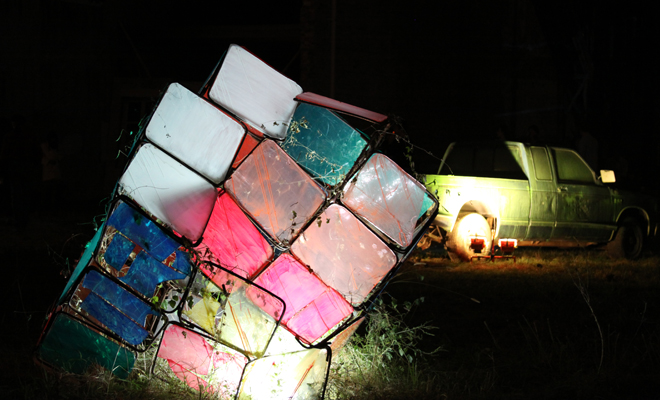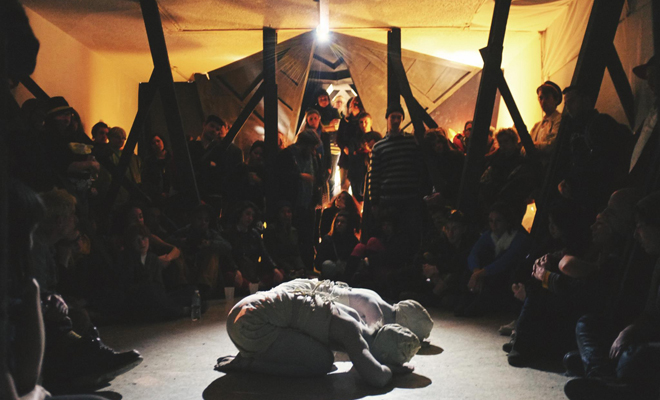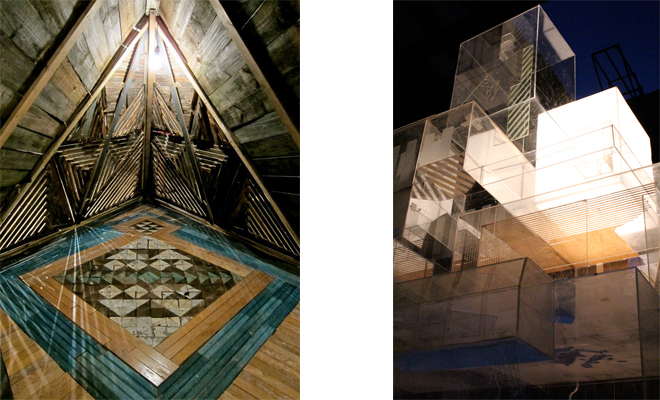Parse’s Moving Castle

Night falls on a glowing oversized Rubik’s cube created by Andrew Schrock for the one-night event "Between the Tracks."
Few young galleries in New Orleans have been bestowed with such extraordinary spatial possibilities as Parse Gallery. Their efficacious use of the building located at 134 Carondelet Street has enabled the presentation of several significant architecturally-motivated immersive environments and experiential sculptural installations over the past several years.
Their second exhibition, “Between the Tracks,” a one-night event concurrent with Prospect.2 in 2011, transformed the enormous vacant lot behind their gallery space, which encompasses the crumbling reverse façade of the neighboring Whitney National Bank and other buildings. Those fortunate enough to enter this humble wonder world will remember the slide installed in the back of the gallery that transported visitors to a quizzical yellow brick road paving the way for various sculptures and installations. A teepee constructed by Ricardo Barba and Andrew Schrock, a glowing oversized Rubik’s cube by Schrock, and an audio-enhanced wishing well by Rachel Avena Brown dotted the otherwise empty slice of land. Several dramatically lit plexi architectural sculptures by Alyssa Dennis were framed by the city’s sleek high-rises and hotels, appearing as ghostly apparitions on what remains of the bank’s tile floor. In retrospect, this succession of solitary sculptures hinted at what was yet to come: several large-scale installations, free-standing sculptures, and structures throughout 2012 including Andrew Schrock’s “The Harness of Chaosynchronous” created in collaboration with Rabid Hands Collective in January, Corinne Loperfido’s “The Trust” in May, Serra Victoria Bothwell Fels’ “Between You and the Mountains” in October, and most recently in 2013, “The White Snake” by Amanda Stone and VnessWolfCHild (Vanessa Cronan).

Amanda Stone and VnessWolfCHild performed within the elaborate wooden installation they created for "The White Snake."
Teetering somewhere between vernacular art, set design, and ship building, many of the installations and built environments presented at Parse have precipitated or been created as a setting for music, dance, and performance art. On the opening night of “The Harness of Chaosynchronous,” singers and musicians Cronan and Adriana Atema (known collectively as Wildway) performed a series of melancholic yet quirky songs in Schrock’s colorful hard-angled installation, and several months later, Loperfido’s sumptuous tea room (and the gallery’s street-level display window) was utilized for a series of participatory tableau vivant performances curated by Delaney Martin as part of “The Trust.” The elaborate wooden installation in “The White Snake” recently served as a backdrop for a haunting dance performance by its creators in which audience members were caught between moving performers and the static structure.
Couplings of art and architecture bring to mind New York’s Storefront for Art and Architecture (a nonprofit founded in 1982) or the now defunct Max Protetch Gallery (who began showing architectural drawings in his NYC space in 1978). Both serve(d) as critical and commercial platforms for artists and architects. Parse, however, is more closely aligned with artist-initiated endeavors such as Gowanus Ballroom and Cinders Gallery in Brooklyn, spurring and propagating experimental ideas related to architecture and space that don’t necessarily fit into more normative art venues. Located across town from the cluster of artist-run spaces and alternative galleries in the St. Claude Arts District, and helmed by artists Margot Walsh and Barba, Parse has always been attracted to a slightly atypical approach to the production and presentation of contemporary art, one that takes advantage of the city’s communal nature and history of ad-hoc organizing and programming.
Parse is quite appropriately situated in a place where temporary modes of mobility and display, moving castles of sorts—much like the anthropomorphized structure made famous in Hayao Miyazaki’s Howl’s Moving Castle—are erected annually, only to be destroyed, then salvaged, and then re-adorned the following Mardi Gras season. These magnificent, and at times superfluous, floats serve as stages and settings for myriad performative acts. Parse is also located in the midst of several parade routes on a street where second lines are a frequent occurrence, thus this welcomed yet cacophonous exuberance continually seeps into the structure the gallery occupies. Like Martin’s The Music Box from 2011 (a community-built architectural and sound environment created primarily out of found materials at 1027 Piety Street), the fantastical environments that have been constructed in Parse’s first floor gallery commingle with the sounds and actions that temporarily inhabit their space, filling them with life, if only for a brief moment.
Parse’s repeated embrace of salvaged materials and inspired functionality also recalls the ramshackle boats and shelters that figure so prominently in the sets of the now infamous motion picture Beasts of the Southern Wild. For New Orleanians, of course, such impermanent structures and accumulations are fixtures in the landscape in the form of blighted buildings, makeshift shelters, and abandoned detritus that might remain in place for years, or stands to be disappeared as quickly as amassed. In a city full of transients, lost souls, and passersby, Parse’s exhibitions and installations appear to jibe seamlessly.
In addition to Parse’s program and Martin’s elaborate and immersive sound and structural installations, there have only been a handful of encapsulating room-size or large-scale freestanding structures—worlds unto themselves—recently presented in New Orleans’ ever-growing visual arts community. Brad Benischek and Case Miller (founding members of Press Street/Antenna), in collaboration with Margaret Turner, Ian Vanek, and Guy Pierce, created a dystopian and gritty glimpse of urban decay, evidenced in the two-room installation Breaking up is hard to do at The Front last year. Another, and perhaps more direct parallel, can be found in the geodesic dome The Front built in June 2011, as a result of their exchange with Team Lump in Raleigh, NC (informed in part by the inventions of Buckminster Fuller and the artist community Drop City in Colorado in the 1960s).
The psychic energy that has infused many of the commanding yet inviting installations housed at Parse implies that they are not merely an end in themselves. Much like the experiential approach of The Music Box, such environments are potentially portals to another dimension, a gateway to an intangible, yet enlightening experience. Though an insatiable relationship to structures and spaces is not singular to New Orleans, it figures prominently in the psyche of the city. Countless unoccupied buildings brimming with layers and layers of history—permeated with the sights and sounds of renovations and construction—dominate the landscape. Though a relatively new creative endeavor in this community, Parse Gallery has already proven itself to be a platform for ongoing experiments in spatial and sensorial relationships, aptly positioned in a urban landscape that inspires a constant and perpetual state of becoming.

Left: Serra Victoria Bothwell Fels created a labyrinthian series of hutlike structures for "Between You and the Mountains." Right: Alyssa Dennis installed several dramatically lit plexi sculptures for "Between the Tracks."



